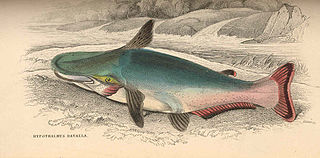
Catfish are a diverse group of ray-finned fish. Named for their prominent barbels, which resemble a cat's whiskers, catfish range in size and behavior from the three largest species alive, the Mekong giant catfish from Southeast Asia, the wels catfish of Eurasia, and the piraíba of South America, to detritivores, and even to a tiny parasitic species commonly called the candiru, Vandellia cirrhosa. Neither the armour-plated types nor the naked types have scales. Despite their name, not all catfish have prominent barbels or "whiskers". Members of the Siluriformes order are defined by features of the skull and swimbladder. Catfish are of considerable commercial importance; many of the larger species are farmed or fished for food. Many of the smaller species, particularly the genus Corydoras, are important in the aquarium hobby. Many catfish are nocturnal, but others are crepuscular or diurnal.

The Doradidae are a family of catfishes also known as thorny catfishes, raphael catfishes or talking catfishes. These fish are native to South America, primarily the Amazon basin and the Guianas.

The Aspredinidae are a small South American family of catfishes also known as the banjo catfishes, with about 43 species.

The striped Raphael catfish is a catfish of the family Doradidae. It may also be called Southern striped Raphael, talking catfish, chocolate doradid, chocolate catfish or thorny catfish. It is native to the Amazon, Paraguay–Paraná and lower Orinoco basins in South America. This peaceful, nocturnal species is a popular aquarium fish due to its pleasant temperament and curious nature. Despite its name "talking catfish", it does not speak.

Platydoras costatus, the Raphael catfish, is a species of thorny catfish native to rivers in Brazil, Suriname and French Guiana. It was long confused with other species in the genus Platydoras, especially the more widespread "true" striped Raphael catfish. P. costatus grows to a length of 24 cm (9.4 in) SL, and unlike P. armatulus the light stripe along the body of P. costatus does not extend onto the head. This fish is a minor component of local fisheries and is also found in the aquarium trade.

Platydoras is a small genus of thorny catfishes native to freshwater habitats in subtropical and tropical South America.
Astrodoras is a monotypic genus with the only species Astrodoras asterifrons of catfish family Doradidae. This species originates from the Amazon basin of Bolivia and Brazil and reaches a length of about 8.0 centimetres (3.1 in) SL. This genus is the type genus of the subfamily Astrodoradinae.
Kalyptodoras bahiensis is the only species in the genus Kalyptodoras of the catfish family Doradidae. This species is endemic to Brazil where it is found in the Paraguaçu River in the northeast and reaches a length of 24.5 centimetres (9.6 in) SL.
Wertheimeria maculata is the only species in the genus Wertheimeria of the catfish family Doradidae. This species is endemic to Brazil and is found in the Jequitinhonha and Pardo Rivers. These fish reach a length of 30.0 centimetres (11.8 in) SL. Within its restricted range, W. maculata faces strong human habitat disturbances such as siltation, habitat fragmentation, pollution, and introduced species. This fish has been placed as the sister taxon to all other doradids.
Merodoras nheco is a species of freshwater ray-finned fish, it is the only species in the genus Merodoras of the catfish family Doradidae.

The giant talking catfish or giant raphael catfish is a species of thorny catfish that is native to the Amazon Basin in Bolivia, Brazil, Colombia, Ecuador and Peru. This species grows to a length of 60 centimetres (24 in) SL and a maximum weight of 4.6 kilograms (10 lb). These fish are harvested in local commercial fisheries.

Opsodoras is a genus of thorny catfishes native to the Amazon basin of South America.
Hassar is a genus of thorny catfishes native to South America.
Ernstichthys is a genus of banjo catfishes that occurs in the Amazon and Orinoco basins.
Rhynchodoras woodsi is a species of thorny catfish endemic to Ecuador where it is found in the Bobonaza River of the upper Amazon River drainage. This species grows to a length of 10.5 centimetres (4.1 in) SL.
Anadoras regani is a species of thorny catfish found in the Oyapock and Amazon basins of Brazil, French Guiana, and Colombia. This species grows to a length of 11.0 centimetres (4.3 in) SL. The IUCN Red List considers it a junior synonym of Anadoras weddellii.

Anadoras weddellii is a species of thorny catfish that is found in Argentina, Brazil, Bolivia and Paraguay. This species grows to a length of 15.0 centimetres (5.9 in) SL. The IUCN Red List considers Anadoras regani a junior synonym of Anadoras weddellii, but FishBase and the Catalog of Fishes regard it as valid.

The granulated catfish is a species of thorny catfish found in the Paraná and Amazon basin as well as the coastal drainages of Suriname and Guyana. This species is commercially caught for human consumption as well as being displayed in public aquaria.

Ageneiosus inermis is a species of driftwood catfish of the family Auchenipteridae. It can be found throughout South America, from Colombia and Venezuela to Uruguay and northern Argentina.

Loricariichthys stuebelii is a species of catfish in the family Loricariidae. It is native to South America, where it occurs in the Huallaga River basin in the upper Amazon River drainage in Peru. The species reaches 19 centimetres (7.5 in) in standard length and is believed to be a facultative air-breather.












